Let get start on a captivating journey into Vietnam’s history through its network of underground Vietnamese tunnels! From the iconic Cu Chi Tunnels to hidden gems like Vinh Moc, these remarkable sites offer a glimpse into the country’s past and its remarkable spirit. Explore these historic marvels and gain valuable insights into Vietnam’s resilience in the face of challenges.
See more: Discover Vibrant Vietnamese Culture on Your Adventure
Contents
Unraveling the History of Vietnamese Tunnels
A Legacy of Resilience
The construction of tunnels in Vietnam represents a longstanding testament to the nation’s enduring resistance against foreign invaders. From early encounters with Chinese rule in the 10th century to the French colonial period in the 19th and early 20th centuries, Vietnamese communities adeptly utilized tunnels for shelter, communication, and guerilla warfare tactics. However, it was during the Vietnam War (1955-1975) that the construction and utilization of tunnels reached unprecedented levels of complexity and scale.
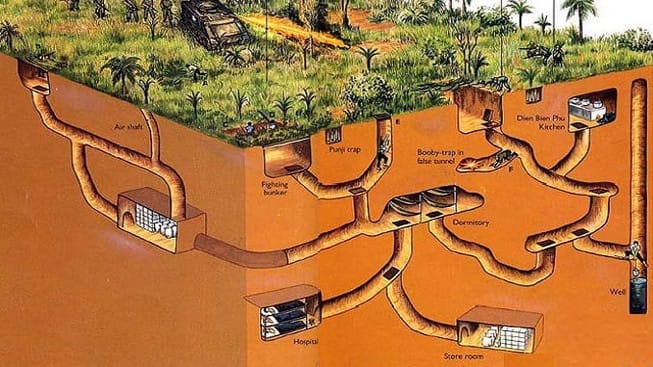
A Network of Functions
Crafted by hand using simple tools and local materials, these tunnel networks served a myriad of purposes during the Vietnam War, functioning as:
- Hidden havens: Providing crucial hiding places for both military personnel and civilians, offering protection from enemy air raids, artillery bombardments, and chemical attacks.
- Military infrastructure: Serving as vital logistical networks, facilitating the movement of troops, supplies, and communication between different sectors of the resistance.
- Guerilla warfare bases: Enabling surprise attacks and ambushes on enemy positions, significantly enhancing the effectiveness of guerilla warfare tactics.
Beyond the Battlefield
The impact of these tunnels on the course of the Vietnam War was undeniable. They provided the North Vietnamese and Viet Cong with a significant advantage in their fight against a technologically superior enemy, disrupting enemy operations and inflicting substantial casualties.
A Lasting Legacy
Today, several sections of these tunnels have been preserved as historical landmarks, serving as poignant reminders of Vietnamese resilience and ingenuity in the face of adversity. Exploring these remnants offers visitors a unique perspective on the war, allowing them to appreciate the remarkable determination and resourcefulness displayed by the Vietnamese people.
Explore the Top 9 Famous Vietnamese Bridges in your Vietnam trip.
Touring Iconic Tunnel Destinations in Vietnam
Vietnam’s subterranean landscape holds a fascinating history, woven with intricate networks of tunnels that played a pivotal role in various conflicts throughout the centuries.
Cu Chi Tunnels, Ho Chi Minh city
Cu Chi Tunnels, situated in the Cu Chi district, approximately 70 km northwest of Ho Chi Minh City, stand as an enduring symbol of Vietnam’s indomitable spirit. Initially dug during the Indochina War and further expanded during the Vietnam War, this underground defense system served as a vital stronghold for the Viet Minh resistance army and the National Front for the Liberation of South Vietnam.
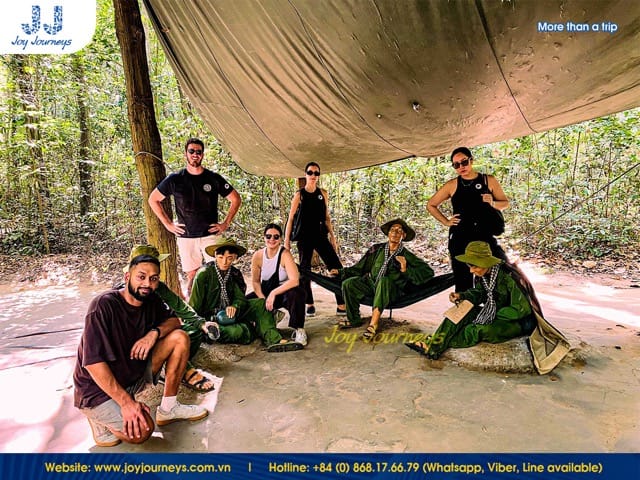
The intricate network of tunnels comprises an array of facilities, including an infirmary, multiple rooms, a kitchen, a warehouse, and a working area. Stretching over approximately 250 km, the tunnels boast a sophisticated ventilation system cleverly concealed amidst the surrounding foliage. Positioned at the terminus of the Ho Chi Minh Trail, the tunnels epitomize the unwavering determination of the local populace and soldiers, earning the moniker “steel land” in tribute to their steadfast defense.
During the pivotal 1968 Tet Offensive, the Southern Liberation Army launched attacks from these tunnels, underscoring their strategic significance in the conflict. In the aftermath of the war, Cu Chi Tunnels attained national historical site status, a testament to their historical and cultural significance. In recognition of its exceptional contributions, the site was honored with the prestigious title of Hero of Labor in 2015, highlighting its outstanding achievements in labor and creativity.
Today, Cu Chi Tunnels have evolved into a premier tourist destination, attracting millions of domestic and international visitors annually. With approximately 120 km of tunnels preserved and accessible, tourists have the opportunity to delve into the region’s tumultuous past and experience life underground as former residents did. From exploring the labyrinthine passages to sampling dishes reminiscent of tunnel-dwelling inhabitants, visitors are immersed in the rich history and resilience of the Vietnamese people.

For many tourists, particularly veterans, a visit to Cu Chi Tunnels is a poignant journey of remembrance and reflection. As they navigate through the tunnels and witness firsthand the ingenuity of those who once inhabited them, a profound appreciation for the sacrifices made during the war is evoked.
In February 2016, Cu Chi Tunnels received the esteemed designation of Special National Monument, further solidifying its status as a revered historical landmark. As a living testament to Vietnam’s enduring spirit and resilience, Cu Chi Tunnels continue to captivate and inspire visitors from around the globe, preserving the legacy of those who fought bravely for their nation’s freedom.
Leave your sorrow behind and dive into Vietnam Villages – the Cultural Gems for Enthusiasts.
Vinh Moc Tunnels, Quang Tri
Nestled in Vinh Linh district of Quang Tri province, the Vinh Moc Tunnels stand as a poignant reminder of Vietnam’s tumultuous past and the unwavering spirit of its people. Constructed during the Vietnam War by the Democratic Republic of Vietnam, these tunnels served as a vital lifeline for local inhabitants, offering refuge from relentless attacks by the Republic of Vietnam and the United States of America.
Stretching north of the Ben Hai River and Hien Luong Bridge, the Vinh Moc tunnel system was a testament to human ingenuity and determination. Carved deep into the red basalt hills, the tunnels were strategically positioned higher than sea level, ensuring efficient drainage and providing shelter even during the rainy season. Despite their subterranean location, the tunnels were equipped with essential amenities, including water wells, rice warehouses, kitchens, guard stations, and even facilities for medical care and childbirth.
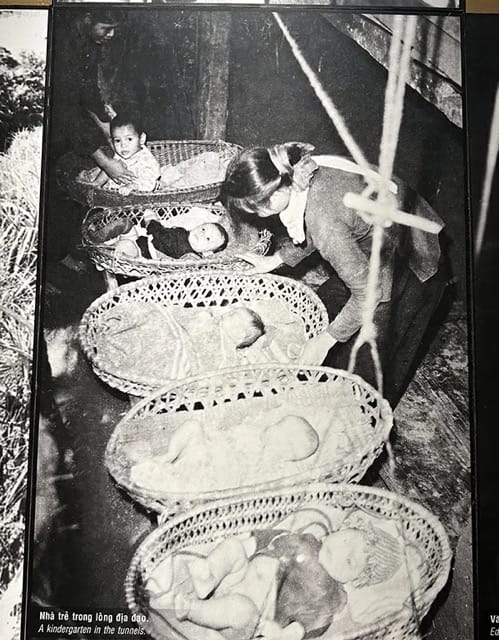
One of the most remarkable features of the Vinh Moc Tunnels is their unique architectural design. The tunnels are punctuated with a total of 13 doors, with seven opening towards the sea and six leading inland. This ingenious layout not only facilitated ventilation but also ensured a constant temperature inside the tunnels, offering respite from the sweltering heat of summer and the biting chill of winter.
Since 1995, the Vinh Moc Tunnels has welcomed visitors from far and wide, offering a glimpse into the lives of those who sought refuge underground during one of the darkest chapters in Vietnam’s history. As visitors explore the labyrinthine passages of the Vinh Moc Tunnels, they are transported back in time, gaining a deeper understanding of the hardships endured by the Vietnamese people during the war. The tunnels stand not only as a testament to the sacrifices made by past generations but also as a symbol of hope and perseverance in the face of adversity.
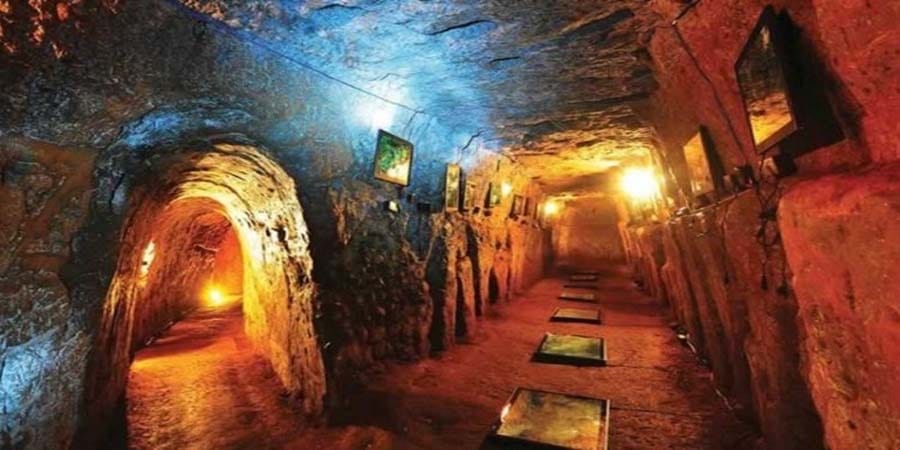
In a world marked by conflict and strife, the Vinh Moc Tunnels serve as a powerful reminder of the resilience of the human spirit and the enduring legacy of those who dared to defy the odds in pursuit of freedom and dignity.
Nhon Trach Tunnels, Dong Nai
Nestled in the heart of Dong Nai Province, the Nhon Trach Tunnels, also known as Phuoc An Tunnels, stand as silent witnesses to the courage and determination of the soldiers and people of Nhon Trach during the resistance war against the US. Located in Hamlet 5, Long Tho Commune, Nhon Trach District, these tunnels were instrumental in directing attacks on the enemy, serving as a strategic base for the Nhon Trach District Party Committee.
Constructed with unwavering resolve, the Nhon Trach Tunnels delve deep underground, reaching depths of 5m to 7m. Crafted with ingenuity, the tunnels boast dimensions ranging from 1.6m to 1.8m in height and 1m to 1.2m in width, allowing for seamless movement for the Vietnamese forces while posing challenges for the towering enemy soldiers. The tunnels’ zigzagging layout and numerous alcoves further ensured swift mobility and escape in the event of an encounter with the enemy.
Central to each tunnel section is a carefully crafted niche and funnel-shaped vent, along with secret compartments camouflaged beneath a layer of soil. These compartments, with wooden lids and a thickness of 1m, served as crucial hiding spots and strategic points of defense. Additionally, round holes were strategically placed in partitions, allowing for discreet movement while minimizing the risk of detection by the enemy.
Today, efforts to preserve and honor the historical significance of the Nhon Trach Tunnels have resulted in the restoration of a 200m-long tunnel and the reconstruction of the workplace of the Nhon Trach District Party Committee. Situated on a 2.5-hectare land area, the site also features a traditional house displaying documents, images, and artifacts from the era, offering visitors a glimpse into the heroic past of the region.
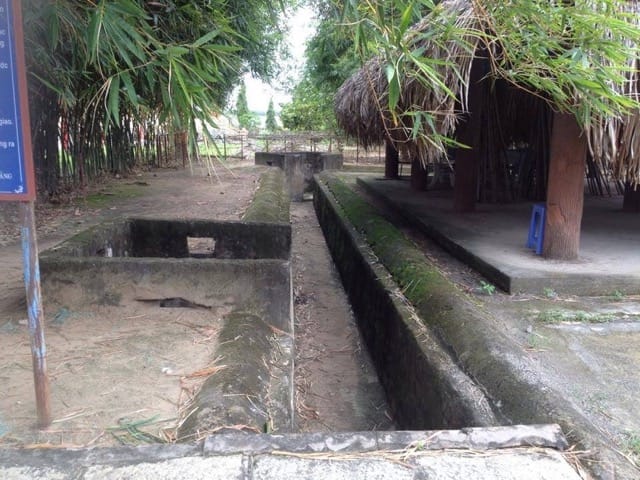
Each year, numerous tourists, particularly students, flock to the Nhon Trach Tunnels to immerse themselves in the rich history and cultural heritage of the area. Through these visits, they pay homage to the courageous soldiers and resilient people who once fought tirelessly for their nation’s freedom and sovereignty, ensuring that the legacy of their sacrifices lives on for generations to come.
Khe Trai Tunnel in Thua-Thien Hue
Khe Trai Tunnel stands as a testament to the region’s rich history and resilience. During the pivotal 1968 Spring Mau Than campaign, this tunnel served as a vital hub, housing the headquarters of the Tri Thien Hue Military Region Command.
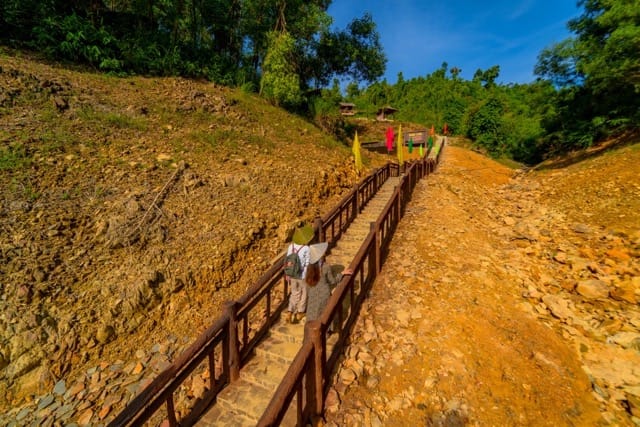
Perched on the slope of hill 160, approximately 160 meters above sea level, the Khe Trai Tunnel comprises three gates, each playing a crucial role in directing the activities of the liberation army forces during and after the Spring 1968 Uprising General Offensive. The tunnel, recognized as a national relic by the State, boasts intricate dimensions and features, including sleeping tunnels and a meeting chamber adorned with pieces of dry wood used as pillars for hammocks.
The tunnel complex is replete with various structures, including a memorial stele house, guard tunnels shaped like a Y, monument introduction signs, and huts for resting and admiring the surrounding scenery. The Hoang Cam kitchen and artillery battle installations atop the mountain further underscore the strategic importance of this historic site.

Surrounded by quaint houses scattered along the stream and hillsides, the Khe Trai Tunnel offers visitors a glimpse into the region’s past and the sacrifices made by those who fought for Vietnam’s freedom and sovereignty. Through its preservation as a national relic, the Khe Trai Tunnel continues to serve as a poignant reminder of the resilience and determination of the Vietnamese people during times of conflict.
Vinh Linh Tunnel Village, Quang Tri
Amidst the backdrop of conflict, Vinh Linh Tunnel Village emerges as a testament to human resilience and ingenuity. In the face of relentless aerial assaults during the war, the people of Vinh Linh defiantly retreated underground, creating a remarkable network of 114 tunnels and underground villages.
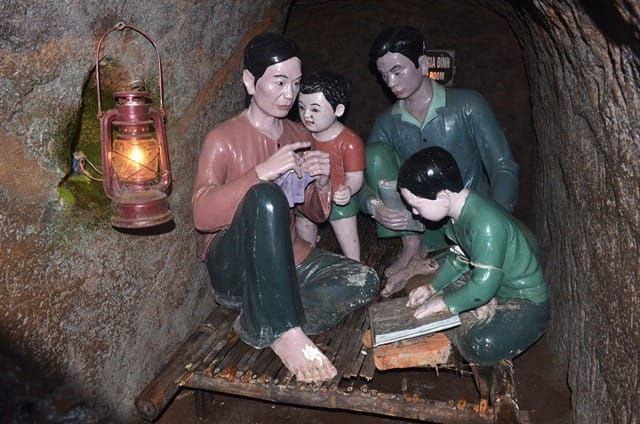
From 1965 to 1972, this subterranean labyrinth stretched across 70 villages, weaving through 15 communes and towns, embodying the unwavering spirit of the local community. Braving the storm of war, they clung to their homeland with the determination to “not move an inch, not leave an inch.”
Today, Vinh Linh Tunnel Village stands as a living testament to their courage and resourcefulness. Visitors can explore the Vinh Moc tunnels, marveling at the architectural marvels and feeling the pulse of history echoing through the underground passages.
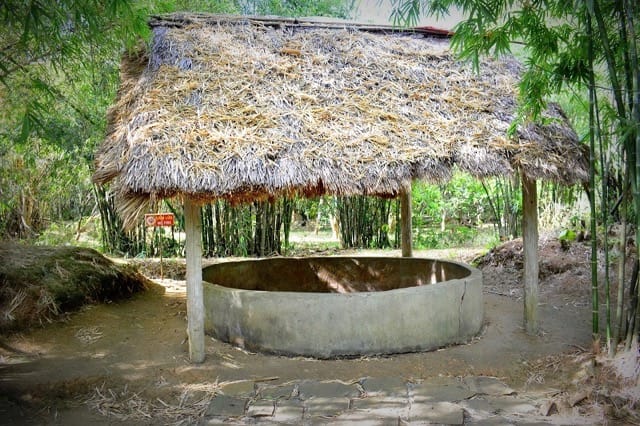
But the wonders of Vinh Linh extend beyond Vinh Moc. With hidden treasures like Mui Sy, Rooc village, Troong Mon – Cua Hang, Hai Quan, Huong Nam, armed police tunnels, and tunnel 61 waiting to be discovered, there’s no shortage of adventures to be had.
Unlocking the Secrets of Cu Chi Tunnels
For those seeking a glimpse into Vietnam’s tumultuous past, the Cu Chi Tunnels offer a captivating journey through history. Here’s everything you need to know:
- Ticket Information: 65,000 VND per person. Tickets can be purchased at the entrance to the Cu Chi Tunnels complex.
- Operating Hours: Monday to Sunday: 7 AM–5 PM
Cu Chi Tunnels Tour
Exploring the Cu Chi Tunnels is a must for any visitor to Vietnam, and opting for a guided tour ensures a smooth and enriching experience. Here’s why choosing a tour is the ideal way to delve into this historic site:
- Comprehensive Transportation from Ho Chi Minh City: Sit back, relax, and enjoy the scenic journey as you’re whisked away to your destination.
- All-Inclusive Ticket and Admission.
- Expert English-Speaking Guides.
- As part of your tour, indulge in a unique tapioca tasting experience. Learn about the significance of tapioca during the war and savor its distinct flavor and texture.
Highlights of the Attractions:
- Explore an intricate network of tunnels used by Vietnamese soldiers during the Vietnam War.
- Discover underground bunkers, weapon storage areas, and command centers.

Shooting Range in Cu Chi – Source: Collected - Experience the ingenious booby traps and camouflage techniques employed by the Viet Cong.
- Witness demonstrations of traditional weapons and wartime artifacts.
Embrace the opportunity to discover the hidden gems nestled within Vietnam’s picturesque valleys and create cherished memories that will last a lifetime.
Conclusion
As we conclude our journey through Vietnam’s historic tunnels, we’ve gained profound insights into the country’s resilience and ingenuity. Encouraging travelers to explore these sites firsthand, we appreciate their significance in Vietnamese history and culture. From the Cu Chi Tunnels to Vinh Moc and beyond, each tunnel tells a story of courage and survival, offering a window into the indomitable spirit of the Vietnamese people.
Frequently Asked Questions (FAQs)
1. Do Viet Cong tunnels still exist?
Yes, many Viet Cong tunnels still exist in Vietnam today, serving as historical landmarks and tourist attractions. One of the most famous tunnel systems, the Cu Chi Tunnels near Ho Chi Minh City, is a well-preserved example of Viet Cong tunnels.
2. What are the famous tunnels in Vietnam?
Some of the famous tunnels in Vietnam include the Cu Chi Tunnels, Vinh Moc Tunnels, and Nhon Trach Tunnels. These tunnels played significant roles during the Vietnam War and are now popular tourist destinations, offering insights into the country’s history and resilience.
3. Why did the Vietnamese have tunnels?
Vietnamese tunnels served multiple purposes, primarily during times of conflict such as the Vietnam War. They were used for shelter, communication, transportation, storage, and as hiding places from enemy attacks. Additionally, the tunnels allowed for strategic movement of troops and supplies, contributing to the Vietnamese resistance efforts against foreign invaders.


Related Posts
Saigon’s “Flower Market Replica”: Where To Find Them
Ho Chi Minh City’s floral charm is not limited to its bustling wholesale markets. Imagine wandering through a place where vibrant petals, fragrant blooms, and the spirit of traditional Vietnamese markets come alive—without the overwhelming crowds. A flower market replica captures that magic, blending the beauty of fresh flowers with the charm of a curated, […]
Is it Safe to Travel to Vietnam Right Now? A Complete 2025 Guide
Vietnam has emerged as one of Southeast Asia’s most captivating destinations, drawing millions of visitors annually with its rich culture, stunning landscapes, and incredible cuisine. However, many travelers still ask: Is it safe to travel to Vietnam right now? This comprehensive guide provides you with everything you need to know about Vietnam travel safety in […]
Ho Chi Minh Cu Chi Tunnels Tour: The Ultimate Guide
The Cu Chi Tunnels stand as one of Vietnam’s most remarkable historical sites, offering visitors a profound glimpse into the ingenuity and resilience displayed during the Vietnam War. For travelers, a Ho Chi Minh Cu Chi tunnels tour represents an essential experience that combines education, adventure, and deep cultural understanding. This comprehensive guide will help […]